Holiday sounds too good to be true: a dwarf avocado tree that makes large fruit which taste excellent. But it is true . . . kind of.
I planted the Holiday in the photo above four years ago because in that spot I wanted a green screen of privacy year-round that was about head high. I’m now beginning to get privacy, but from an avocado tree I also want avocados. Yet it has not matured a single one. Most of my other avocado trees have had harvests by year four.
Fruit characteristics
Fortunately, I’ve been able to eat Holidays from other people’s trees. The fruit is large, far larger than Hass but smaller than Queen.

Compared to Reed, the shape is a bit less round and the peel is a bit thicker. But compared to Reed, the skin’s green color is nearly identical. Also like Reed, the skin of Holiday doesn’t blacken as it ripens.
The seed size of the Holiday is large, but since the avocado has so much flesh it is not a problem.
Sometimes, Holiday avocados develop rot at the stem end as they’re softening. In my limited experience, this happens more often with Holiday compared to other varieties when home grown and not store bought. I’ve heard from others with similar experiences of Holiday’s imperfect ripening.
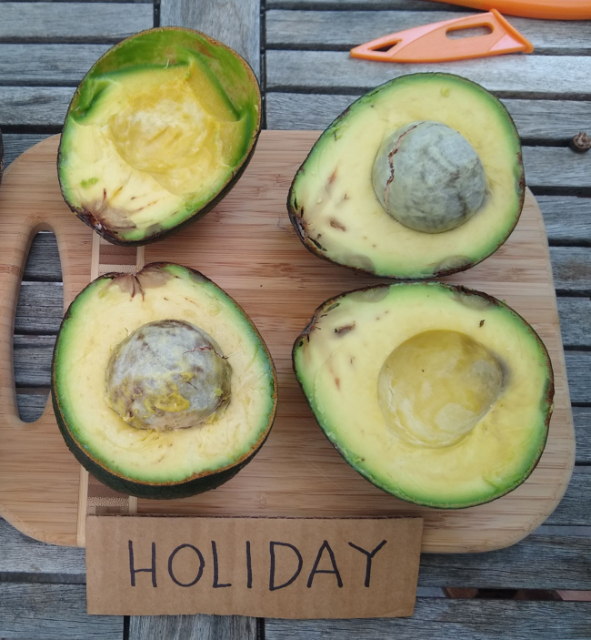
Snap harvesting compared to stem clipping hasn’t made a difference in the incidence of stem end rot on Holiday for me:
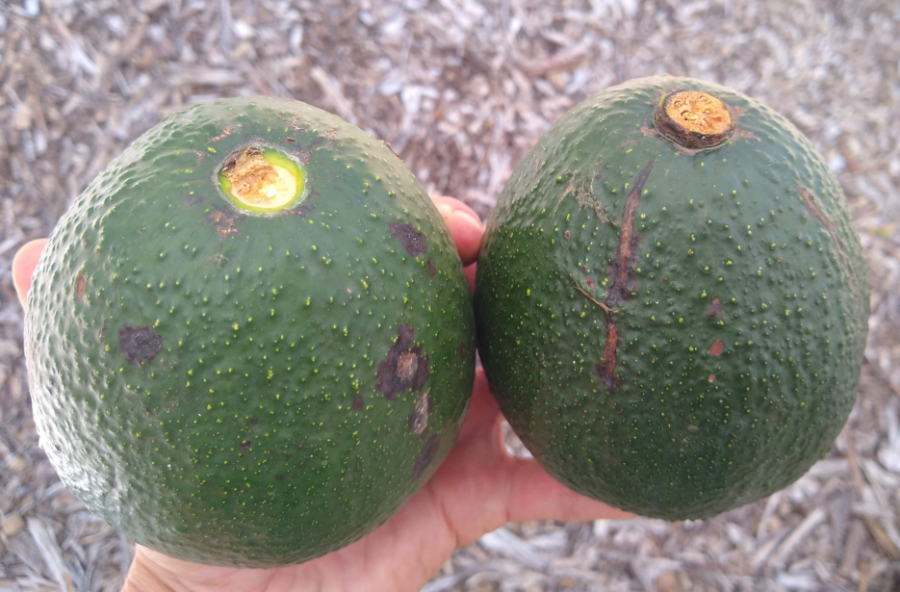
The flesh of the Holiday has only a few fibers. The flesh texture is dense, similar to Gwen, not melting like Bacon.
The flavor is strong and reminding me of Nabal. On June 1, 2020, I gave one of my son’s a half of four avocado varieties: Holiday, Hass, Reed, and Don Gillogly. He said he liked the Holiday a lot but that he liked the Hass and Don Gillogly more. Eventually, he stopped eating all of the varieties except for Hass and he said, “Hass is just the yummiest avocado even though it’s small.” We must remember, however, that Hass is at the peak of its flavor in June here in San Diego County (as is Don Gillogly) whereas Holiday would get a bit richer by hanging on the tree a bit longer, and Reed is barely starting its season in June. So such a side-by-side comparison can never be taken too seriously.
Harvest season
You may have heard that Holiday is called Holiday because its harvest season starts around Labor Day and lasts until Christmas and New Year’s — “the holidays.” I haven’t found this to be accurate, however, at least not for San Diego County. For example, a Holiday tree that I’ve eaten from near the ocean in San Diego matures fruit yearly beginning around May. While I ate a Holiday avocado from a tree in inland San Diego County this past summer on August 27 that had dropped from the tree because it was over mature. Its seed had sprouted inside and grown roots throughout the entire bottom half of the fruit. Even Holiday avocados that I’ve picked in May have had sprouted seeds, indicating full maturity.
Therefore, I would estimate that Holiday’s harvest season in San Diego County runs from about May through July. Locations northward should likely add a month or two.
The harvest chart that Julie Frink has created for varieties in the collection at the University of California’s South Coast Research and Extension Center in Irvine, Orange County, lists the Holiday harvest as July through November.
If the harvest season of Holiday starts as early as May down in San Diego County, then which May is it? This would be the second May after flowering. In other words, the avocados are going to grow on the tree for at least 12 months.
They will look big during their first winter but don’t be fooled. Here I am holding a Holiday avocado in December. Notice that the skin is still shiny:
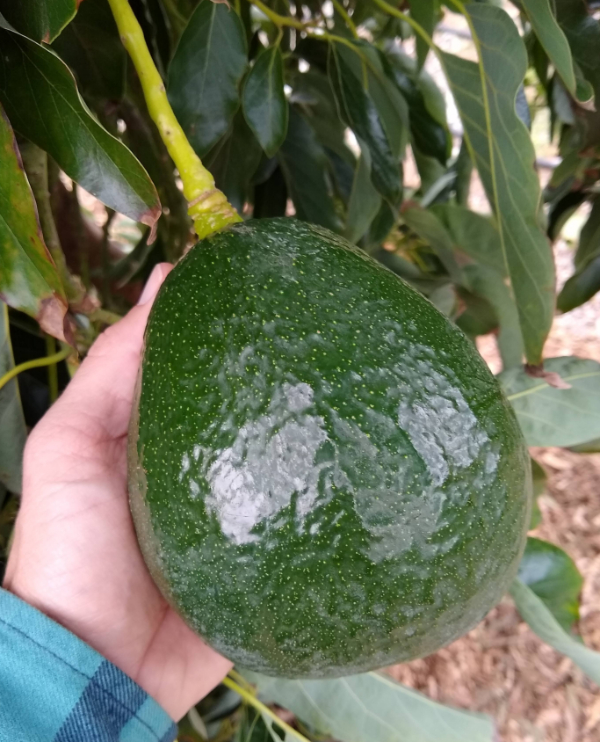
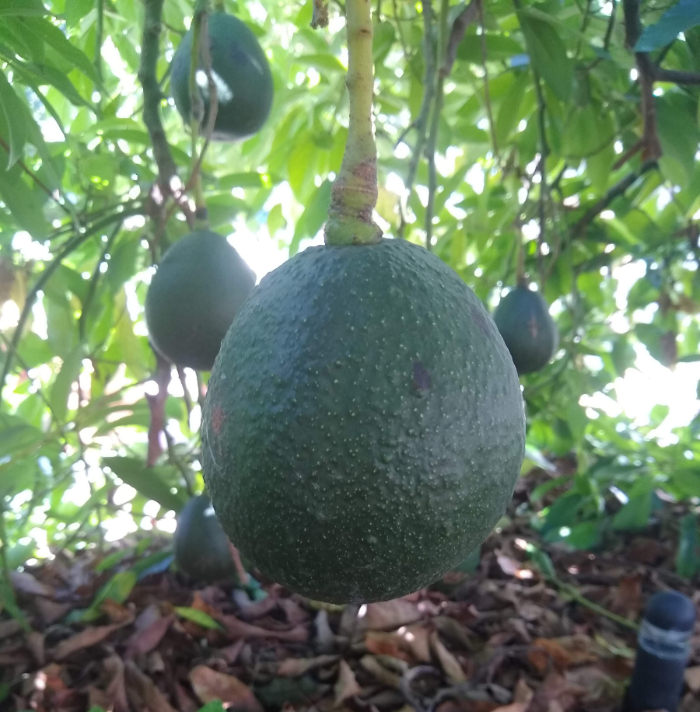
Bearing habit
My current Holiday avocado tree was planted in 2016 and here at the beginning of 2021 it has not held a single avocado to maturity, as I mentioned earlier. But before this Holiday, I grew another Holiday tree for four years in a yard near Balboa Park in San Diego. I inherited the tree with the yard, and it looked to be only a year or two old when I moved in in 2008. Anyway, that’s two Holiday trees for me in two locations, both not giving a harvest within four years. Both of these trees flowered and set some fruit, but the fruit always dropped before being ready for harvest.
I’ve heard similar reports from enough other growers and seen some other trees do the same thing to think that this is a Holiday habit. The habit is that the tree does not bear much fruit early in its life, and it often grows fruit for around a year only to shed it before the fruit is mature.
This is not to say that Holiday avocado trees bear no fruit, however. It’s only to say that I’ve never seen a Holiday tree that is a precocious or heavy bearer. Not even close. In fact, every Holiday tree that I know that is near another avocado tree is outproduced by that other tree. (The other varieties that outproduce nearby Holidays that I know include Pinkerton, Gwen, Don Gillogly, Lamb, Hass, Sir-Prize, and Bacon.)
On the plus side, what fruit Holiday avocado trees do bear are held inside the canopy, covered by ample leaves and protected from the sun. This is an especially desirable characteristic for an avocado tree that is being grown in a hot, inland location. Here is a Holiday tree in inland San Diego County, with fruit well protected by foliage (I promise, there’s fruit in there):

Variety development and history
What we now know as the Holiday variety of avocado was first known as “XX3” within the University of California’s avocado breeding program, from whence it came. And it is said to be a grandchild (a seedling of a seedling) of a variety called Murrieta, or Murrieta Green.
The UC breeding program was looking for new varieties with commercial potential, but Holiday fruit were too large and the tree was too low and sprawling to have a future in commercial groves. Nevertheless, the variety was released in 2001 since it was thought that backyard growers might be interested in a tree with such a growth habit and big, green fruit. (See more notes from Julie Frink and Bob Bergh about the development of Holiday here and here.)
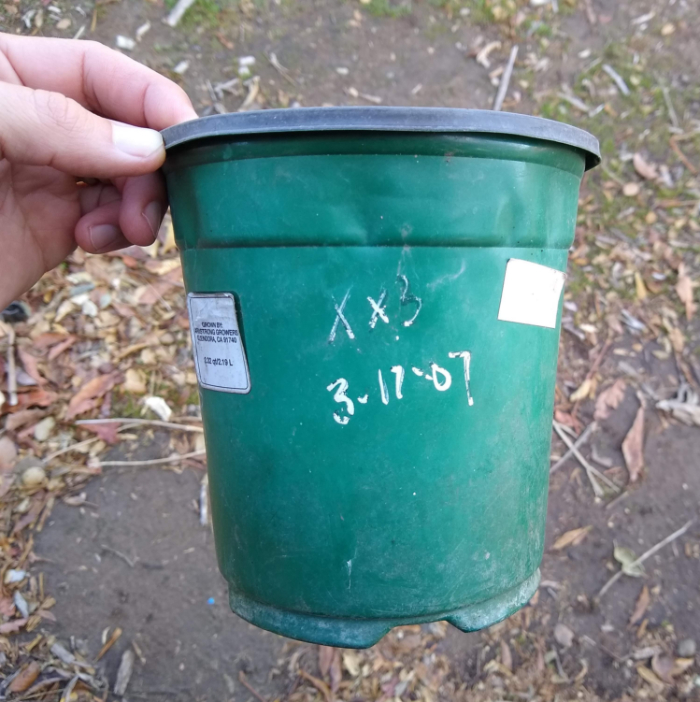
It was a nursery who propagated XX3 trees that began to market them with the name “Holiday.” I don’t know for sure which nursery first used the new name, but the earliest Holiday tree I ever grew was propagated by Durling Nursery and they labeled my tree’s tag “XX3/Holiday.”
Tree shape and appearance
Holiday avocado trees have been described as weeping, dwarf, having a skirting shape, and tending to sprawl on the ground. Holiday avocado trees have also been described as refusing to grow up like a tree, being a weak grower, being a runt.
However you see it, if you want a Holiday to lift itself off the ground and act like a tree as opposed to a shrub, it must be staked. This is my Holiday at two years old, when I thought it would continue growing up like avocado trees do. No need for a stake, right?
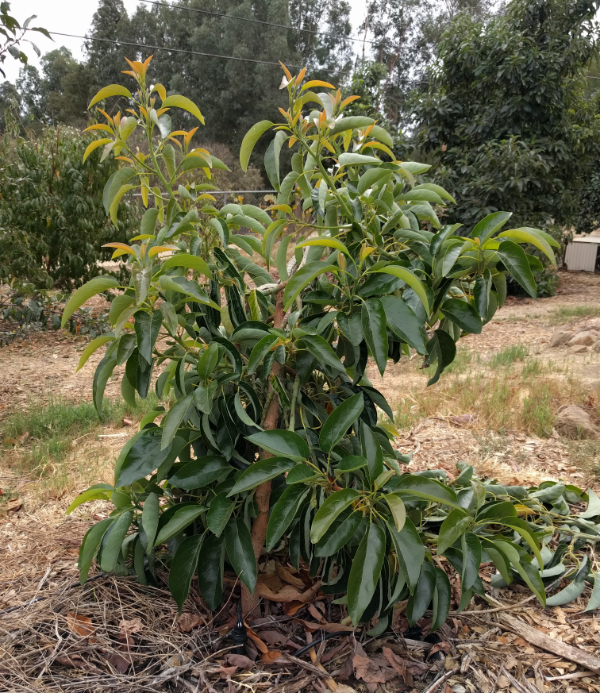
But it flopped and flopped. The trunk didn’t lean; the branches just have a habit of sprouting up and then weeping back down to the ground. So my tree is now staked again at four years old.
If I were growing a Holiday for the first time, I would train it up a two-by-two stake from day one, as this Holiday was trained at the University of California’s South Coast Research and Extension Center in Irvine.
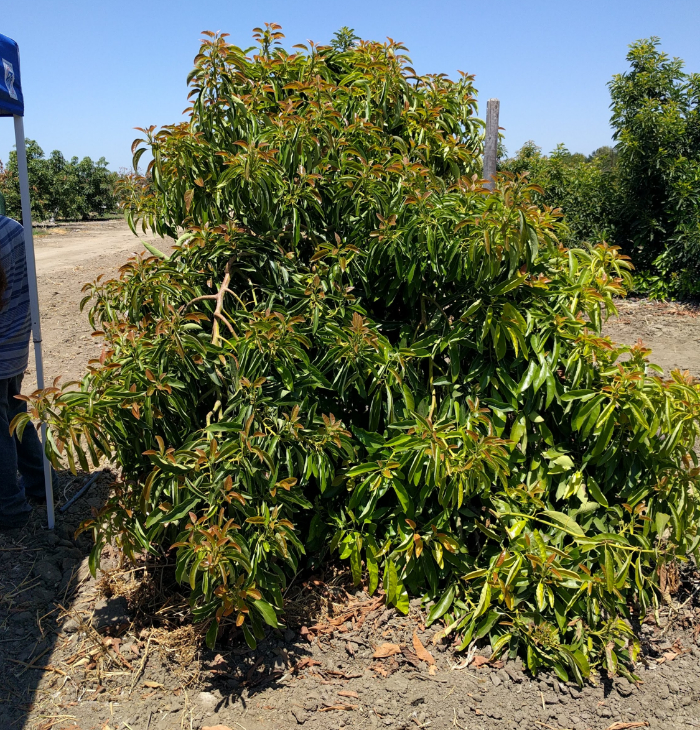
I planted my current Holiday avocado tree at the same time that I planted a Pinkerton avocado tree beside it. Today, the Pinkerton is nearly twice as big, and Pinkerton is not the most vigorous variety.
A friend planted a Holiday and a Don Gillogly only a few feet apart from each other at the same time in 2008. You can see which tree has dominated the other by looking at the trunks:
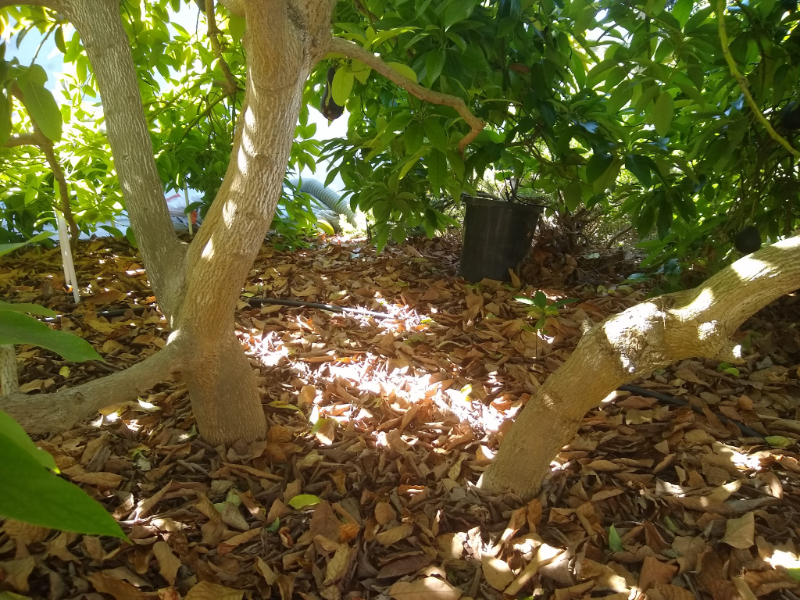
Here are the same trees from the outside, Holiday in front. The Holiday has never been pruned but the Don Gillogly gets pruned a couple times a year to keep its size down.
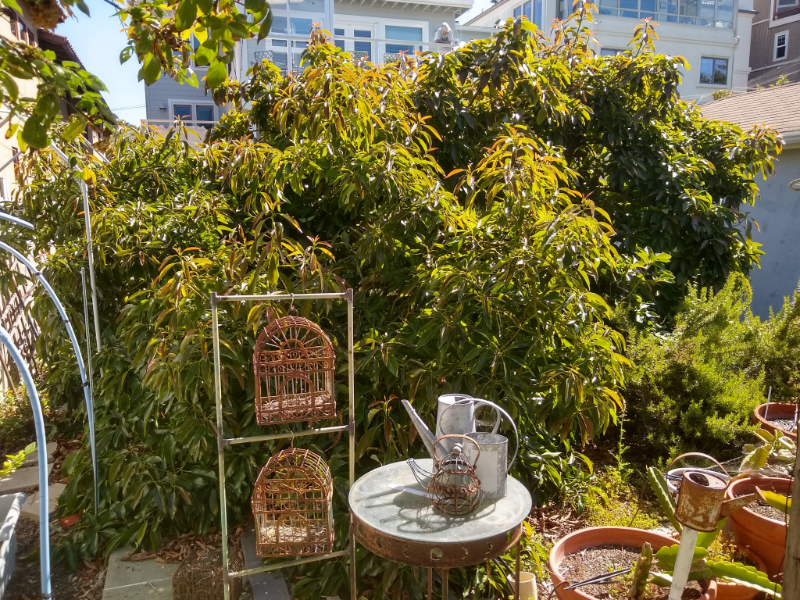
The leaves of a Holiday tree are narrow and cupped for avocado leaves. They remind me of Ficus benjamina leaves. They are attractive and graceful.

Tolerances and vulnerabilities
Holiday avocado leaves also show moderate tolerance to both heat and chloride in irrigation water or insufficient irrigation. I’ve noticed this in my own Holiday trees as well as others.
I’ve also observed Holiday avocado trees with fewer persea mites compared to other varieties of avocado nearby.
Is Holiday a fit for your yard?
Should you plant a Holiday avocado tree in your yard? It depends on what you want out of an avocado tree and the space you have.
Holiday really does deserve the label dwarf, and I know of no other avocado variety that is commonly available that grows as slowly and in a mounding fashion. So if you’d like an avocado tree that naturally shapes itself like a bush, then Holiday fits the bill.
Holiday really does make large avocados that taste excellent. Frankly, Holiday’s fruit is bigger than I prefer, but there’s no doubt that its size impresses some people. And though I have heard a few people who aren’t impressed by Holiday’s taste, I have met more who find them delicious. In terms of overall eating, they aren’t quite in my personal top tier, but they are very good and I would never turn one down.
Yet, Holiday doesn’t make many of those big, delicious avocados. If you want to get the most fruit out of the smallest tree, Holiday does not meet that efficiency standard. You could probably get more fruit out of a small avocado tree by instead growing varieties such as Pinkerton, GEM, Wurtz, Gwen, or Lamb. These varieties would all require pruning in order to keep them down to a size that Holiday would keep itself naturally, but if harvesting the most avocados as possible out of the smallest tree is your goal then that is the recipe I would follow.
Add a Holiday to a collection of avocado trees, but if you lack yard space and desire a single small, productive tree, then I believe there are better options.
Here’s my video profile on the Holiday avocado tree:
See my other profiles of avocado varieties HERE
All of my Yard Posts are listed HERE

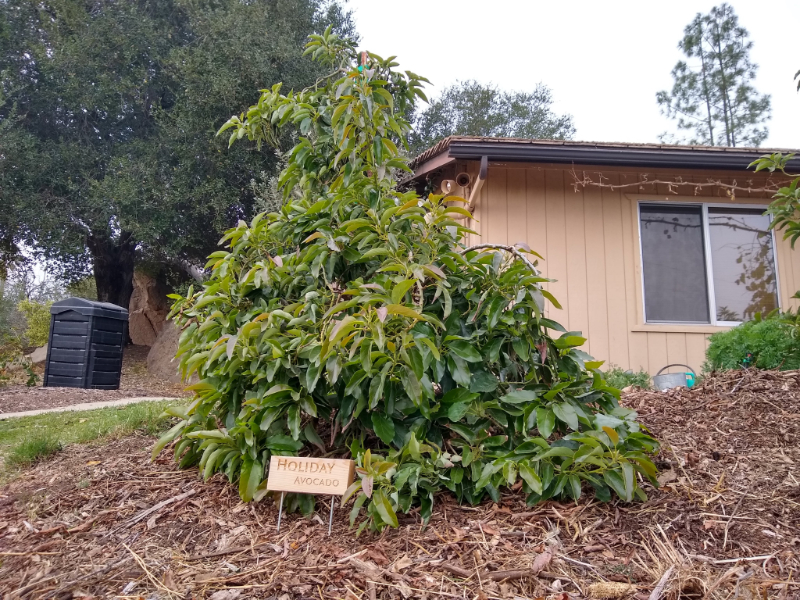


Hi Greg, thank you very much for you’re useful posts.
I have a 3 year old Hass avocado tree which has 3 avocados on it. When is time to harvest them?
Hi Zahra,
Thank you. Your three-year-old Hass has three avocados, but my four-year-old Holiday has none. Ha!
Check out these posts for harvest timing information on Hass:
https://gregalder.com/yardposts/the-hass-avocado-tree-a-profile/
https://gregalder.com/yardposts/when-to-pick-avocados/
I love reading all your posts. They are very educational ^_^ I learned so much.
Thanks very much, Kesirin!
⁹hi greg- I had a holiday which was exactly as you describe- weeping and no fruit. But it was moved, the tree appeared to not survive the transplant. Then after a couple monthsbit got new growth but its not the traditional weeping branches- very vigorous and upright. I was wondering- is the holiday typically grafted onto hardier rootstock, and this rootstock varietal is what is growing so upright? The leaves do look like a holiday, just not the growth pattern.
Hi David,
Holiday can send up some vertical, vigorous shoots occasionally. I have seen that. But you might be seeing rootstock suckers. Yes, Holiday trees are grafted onto rootstocks that are usually far more upright than Holiday. Try to see if the branch emanates from down low near the ground, below the graft union (which might look like a swelling in the trunk).
Hi!
We planted our Holiday around 2004 and had 2 or 3 fruit per year for the first 4 years. We were about to take it out for lack of performance when I explained the situation to a Master Gardener. He came over and tried something called “girding” which removed the cambium from one of the branches. The theory was that the tree would force carbohydrates up that branch in order to heal the wound. Well the next year we had 50 avocados and it’s been almost the same ever since. The fruits are delicious and are ready from July to November. It’s also about 12-15 feet high. We’re in the mid-city area of Los Angeles. Zone 10b
Hi Rayna,
Thanks so much for sharing this. I’ve girdled a few of my other avocado trees but it never occurred to me to try it on my Holiday since the tree is slower growing. (Girdling stresses trees and is generally done only on vigorous varieties like Hass or Fuerte, and even then only on healthy individual trees and vigorous limbs within individual trees.) It’s enlightening to hear that you got positive (and positive in the long term) results from girdling your Holiday. I think I’ll try this on my Holiday next year.
I have to look into “girding”. When would be a good time to do this procedure? My Holiday is five years old and never produced any fruits. Lots of flowers though but all dropped off after blooming. Thanks for the tip. Honestly, if I have a choice, I would not plant this variety. So disappointing.
Hi Loan,
Most people recommend girdling avocados around October or November. Here are a couple resources to explore:
https://youtu.be/CzVHlZrkBqQ
http://www.avocadosource.com/CAS_Yearbooks/CAS_22_1937/CAS_1937_PG_149-153.pdf
Loan don’t give up on your holiday tree mine was 6 years old before it produced one avocado I decided to let it go one more year before I cut it down and it had 20 and this year it has 50
Thanks for the tip, what month of the year did you do the girding?
November and to Loan i would say don’t give up, the avocados are huge and delicious!
Did he girdle the main trunk or just a limb?
Thanks
Bob bradley
I appreciate all the info on the Holiday avocado…we’re going permaculture on our property and want as many fruiting trees as we can possibly fit it. The Holiday definitely has some advantages, especially it’s smaller size and I find it’s weeping shape attractive:–)
Thinking we will leave the Haas, Reed, Fuerte growing to the farmers and continue buying them at the farmer’s market while we have fun with these other types! (I’m headed over to read your other avocado posts over a second cup of coffee.) Thanks!
Thanks, Gene. I love when there’s time for a second cup of coffee!
At this point I would take any avocado tree to grow! Tree 4 just died a few weeks ago. They are shaded in the summer, wrapped in blankets at night in the winter. Well, draining soil, lots go wood chips, you name it! Hopefully this year the nursery will have a mexicola, I hear they are a bit more temperature tolerant.
Hang in there. I’ve lost over six for various reasons. Seems when little they can die easily, however once established can be tough as nails. When we moved here there was a 15 or so year old seedling avo on our back bank it never got a drop of water, no mulch, not near lawn or any source of moisture, yet it survived! Sadily not interested in avos at the time I cut it down. Now I have to work to get em going! My Bacon is thriving 80 avos last year and 60 or so this year. My Holiday, a #15 in the ground two years has 12 fruits. Best of luck.
Hi Elizabeth,
Where are you located? Let’s try to get this avocado thing figured out.
Located in Poway, but in the valley down below Costco. Winter it gets about 10 degrees cooler at night, and summer is probably a bit hotter too. I plant it higher on the hill so it isn’t in the coldest part of the property. We use a spray/ drip system, and water with well water. We have tried fertilizer and no fertilizer always keep thick mulch around the trees. Without fail they just keep dying. Any pointers would be appreciated for this spring when we plant the new one. Our other trees we have planted on the same hill are doing well.
Hi Elizabeth,
Good to know. I know that area pretty well. All of the soils I know around there have good drainage so I doubt that’s your problem.
Because it’s a cold spot in winter, the key for you is to plant up the hill as high as possible, as you’ve done, and then to plant in early March. At that time, the threat of damaging cold is just done and the tree will have maximum time to grow before next winter. Also, planting a bigger tree helps because bigger trees can handle cold nights better. For example, getting a 15-gallon tree from Maddock in Fallbrook would be a good idea, or get one from Walter Andersen’s if they have any good ones.
Then you want to water it plenty to help it put on lots of growth in its first year. See my post for watering avocados:
https://gregalder.com/yardposts/how-much-and-how-often-to-water-avocado-trees-in-california/
https://gregalder.com/yardposts/how-to-water-a-newly-planted-avocado-tree/
Every other tree I know can get by with less water than an avocado. What might satisfy a peach, for example, will not satisfy an avocado. So you might need to make adjustments to your system to ensure that the avocado gets what it needs, which is more than any other fruit tree.
I live within a mile of the coast in Carlsbad. I have a beautiful holiday avocado that produces well. Nice big fruit for my family. When is the best time to pick fruit. When should I fertilize this tree and with what. Thx. B
Hi William,
For Holiday harvest times, read the post above. For my thoughts on fertilizing avocados, check out this post: https://gregalder.com/yardposts/fertilizing-avocado-trees/
Hi Greg,
Thanks for all the helpful info. I am located in south Orange County, I planted a 15 gal holiday in 2016. After the second year it started giving me about 4 fruits per year. I have noted that it is pollinated mostly by flys and smaller insects instead of bees. The tree is surrounded by more enticing flowering fruit trees ( oranges, peaches plums) so perhaps that is why. I will try the girdling option to see if this helps.
great info about the holiday. I don’t think it’s worth it to grow as a stand alone tree. May be grafted onto an existing.
Greg,
I live in North Tustin, CA at an elevation of 600 ft. 2-3 years ago, following all of your avocado guidelines and care, I planted a 15 gal Sir Prize and a 15 gal Reed, about 10-15 ft apart on a well-drained slope with good sun exposure. This past year I got 4 fruit on the Sir Prize tree (2 stolen by critters unknown…), but none on the Reed. The Sir Prize height and amount of foliage is good, but the Reed is still short with very sparse foliage. It does get hot here in the summer, so I painted the tops of the branches white. I am caring for both trees identically, watering every other day for 60 minutes with a microsprinkler. I just can’t figure out why the Reed is growing so slow with so little foliage. Please advise! And when should I start seeing more fruit on these trees?
Hi Bryan,
A couple of possibilities with the Reed to look into: One, it had circling roots in the container when you planted it. This can happen, especially with larger trees like 15-gallons. Two, it’s planted near a large tree or shrub that is drinking its water. If there’s a chance that’s the case, then dig near the Reed to try to identify its roots and the roots of other plants. Young avocado trees cannot compete well with nearby established plants. Three, the rootstock could be a weakling. If you didn’t buy a tree on a clonal rootstock, then you got a seedling rootstock, all of which are somewhat variable. Occasionally, seedling rootstocks will be wimpy in one way or another. (You can see this if you grow a bunch of seeds; some will grow faster or bigger than others.)
If you planted 2-3 years ago from 15-gallon trees, then I’d expect to eat your first avocados this year or next. That’s my rule of thumb based on my own experience. See more explanation on this here: https://gregalder.com/yardposts/how-long-until-an-avocado-tree-fruits/
North Tustin is a great area to grow avocados, and it sounds like you’re watering well. Let me know if any of the above possibilities sound like they might be part of the explanation for the Reed’s slow start.
As to option 1, I don’t remember if it had circling rootstock when I planted it. If so, will it recover?
It’s not near any other plants, which rules out option 2.
Regarding option 3, I bought both trees at Flowerdale Nursery in Orange, CA. I would hope neither tree came from a seed?
Hi Bryan,
You can poke around near the trunk to see if the main roots are spoking out or are curving. If they’re curving a lot, this might indicate that circling roots is the problem. In that case, I’d just replace the tree.
Almost certainly your trees were grafted on seedling rootstocks, which is fine, but it means that there’s the potential that the rootstock that the Reed is on is weak. It’s also possible that the tree just got a poorer start to life in the nursery, and sometimes such trees never catch up to trees that got a good start to life.
Regardless, don’t waste too much time coddling the Reed. If it doesn’t start looking interested in growing and being happy by June, replace it. Even experienced avocado farmers have to replace a small portion of their new plantings every time. It just happens.
Hi Greg – Great blog, just discovered it. We’re interested in planting a dwarf avocado in a limited place off our back patio in Los Angeles. I’ve called around and they are hard to come by. So far I’ve only found one nursery selling the Holiday type in 15 gal containers.
But now reading your post and some of the comments I’m having second thoughts about this variety. Could you recommend another type that might be better from the point of view of small ground area?
Many Thanks
Hi David,
There are some ideas in this post: https://gregalder.com/yardposts/can-you-grow-an-avocado-tree-in-a-small-yard-space/
Greg, you’re the best. I’ve read the linked post as well as some others, and watched your avo watering video as well. I still do have a question or two.
First: We have clay soil; the whole dang neighborhood is so blessed. So naturally I wonder about how an avo would do in our very small clay plot of land. Would you recommend that I build a mound of a few feet in order to protect the tap root? I do note that there are other large avo trees in the ‘hood that are doing well and don’t seem to be raised. But unlike with our situation, they have lots of room around them.
Next: Roots. The space we have available is about 4 feet from a concrete culvert. Is that enough space for the roots to survive without potentially cracking it?
Finally: At this point I’m beginning to wonder if this is even a good idea! Perish the thought, since left unattended I could eat several avocados a day, easy. But if our available area is too small, the soil too clay-ey and packed and other plants too close for comfort, I will reluctantly give up this feverish avocado dream.
Thanks again for your expert help. I greatly appreciate it.
I am kicking myself for not remembering what year I planted my Holiday, but it’s been 12 to 15 years – glad to see the pics – I thought the shrub shape was something I was doing wrong! It’s about 10′ tall and 12′ wide now. Year 1 I had one avocado, year 2 none, year 3 I got 4. Then 12, 22, 45 and it’s been between 45 and 55 avocados a year since. I picked 17 3 weeks ago, and another 12 yesterday. They take 3 – 4 weeks to ripen usually. They’re between a pound and a quarter and a pound and a half ea. I usually start picking them in March, but some usually hide from me until April or even May. I picked 3 in January but only one of those ripened. I’m in Costa Mesa, CA. My next door neighbor also has a Holiday that’s a couple of years older than mine but he only gets about 3 a year (we’re training one of my branches to go over the fence).
Hi, I planted 2 Holiday Avocados in July last year; one in MY suburban garden and the second in my daughter’s nearby. I’m in Belmont, Sunset zone 16-17. We staked them, but the upper leaves of both are yellow and very droopy/wilty. The lower leaves of both, are what I expect of a ‘weeping’ tree, and they’re greener. The soil is not too dry or too wet, and there are lots of flower buds on mine. They are both NOT in full sun, in the winter- they get about 6 hours- but should get full sun in the summer. I fertilized with Citrus/Avocado food when I planted them; should I feed something else.
Thankyou for your advice.
Hi Kerrith,
You’re concerned about those yellow upper leaves? New leaves of Holiday are not usually yellow; they’re more reddish. Tell me how they change in color over the next month or so. I don’t know how or why new leaves on such a tree would come out yellow. However, old leaves do turn yellow before being dropped. See: https://gregalder.com/yardposts/reading-avocado-leaves/
I was considering a Holiday (A) to compliment a Wurtz (A or B). Reconsidering the Holiday now. What might be a smaller variety instead of a Holiday? Would like them to produce at different times of the year. Will be planing in the ground, not a pot. My backyard has some mature mango trees (FL), so I can’t go too big w/the avocado trees as they will compete. I love Calif. Haas and was considering a Fuerte but regular pruning to keep in manageable might not be feasible.
An old Italian farmer in San Jose, CA advises whacking unproductive avocado trees with a 2×4 up and down the trunk to get the tree to fruit. As I understand it, injuring the bark forces the tree to respond in a way that results in fruiting. As a Holiday tree owner, I only had one good productive year out of the 10 years it’s been in the ground (it was potted for 1 year). The good year happened after a season of rain and wind storms knocked it over (it had been staked with a single 2″ round wood pole). The Holiday reminds me of Gumby because it is so green and bendable. It took a lot of heaving to get the tree upright (bent only, not uprooted) again. I accidentally twisted one of 2 major branch leads and I jammed random pieces of wood under heavy branches to support them. The green growth was pretty scraped up. So, perhaps injuring the outer bark is a time tested method of getting an avocado tree to fruit. I plan on trying this method Winter 2021. I had a lot of flowers this year, but only a handful of fruit remains. I also planted a Haas next to the Holiday last year. My son is tired of waiting for the Holiday to produce and he thought the fruit was “oily” compared to the creamy texture of the Haas. I also think I need to prune the Holiday to allow more light into the tree. There’s a lot of interior growth.
Hi Julie,
Damaging the bark in various ways to get a tree to fruit has been tried for a long time and in many places. In Mexico, for example, it’s sometimes done with a machete to mangos.
For avocados, the main technique used is girdling or ringing. It induces more flowering and fruiting sometimes but not always. I say this based on my reading of reports from others and my personal experience.
Most people in California girdle avocado trees in late October or early November.
It’s interesting to me that your Holiday responded and recovered well after being knocked over since Holidays aren’t fast growers.
If you try some form of girdling again this year, let me know how it goes. I might try it on my Holiday this year.
UPDATE: I did not try girdling but did do some damage to the trunk and larger branches. This was due to the tree growing a couple of large vertical branches very quickly, flopping over in the wrong direction and my heavy handed redirecting southward. I also did a lot of research on Holiday trees and learned a few new things.
First, pollination (Holiday is supposedly self-fertile) by bees is challenging when the backyard contains better tasting flowers, like citrus. I found some videos posted by Laguna Hills Nursery and learned that spraying the flowers with a honey-water mixture will encourage bees to visit the tree. The videos are excruciatingly slow and long, as they are recordings of in person classes held at the nursery, but they contain useful info. I did spray my Holiday tree and found I had many baby fruit set . . . initially.
Second, I live in Nor Cal (Mtn. View) and believe that heat, humidity and irrigation play significant roles in growing Holiday well. Because of the drought we’ve been enduring, I have not been watering as much as normal. I also failed to notice my drip irrigation was messed up on one side of the tree, so there was one side that was very dry. The weather was unusually cool from spring through summer, averaging low 80s most of the time. It was also a very dry winter and spring. So, of the 30 to 40 babies that set, I have 6 nice large fruit. I also have 2 runts that are about the size of my thumb and appear to not have a seed. I found a guy in FL who has been successful with Holiday and he has this great post on his website:
https://www.myavocadotrees.com/holiday-avocado.html
Something tells me that the FL weather is wetter, hotter and more humid than the SF Bay Area (South), and this is probably the reason my Holiday has not done well since the season it was knocked over during an El Nino storm year. There was just so much more water.
Last, encroaching shade from my neighbor’s overgrown trees affected my Holiday’s growth and health. I paid someone to hack their trees back to the fence line and it provided much more sun this year. My Holiday grew really well in response and so I have decided to give it at least one more year.
I am very encouraged by the FL grower’s success. He got so many fruit off a fairly young tree. He also was able to harvest mature fruit within one season, instead of two. He noted Holiday may be an every other year bearer, and that the branch that bears fruit seemed to die back after harvest. I will have to see how the tree flowers next year and will update again if there’s success. For now, my Holiday avocados are still shiny but one seems like it’s dulling up.
I know you (Greg) have cut down your Holiday at this point, but hopefully this info will assist other gardeners who are still trying.
Thanks for the update, Julie. You have the patience necessary to grow a Holiday tree. Obviously, I did not.
Just so you know. Carlos, the grower in Florida who reports on his trees at myavocadotrees.com, grafted his Holiday onto a mature rootstock. “Topworking” it is called. When that is done the tree grows much faster and fruits earlier compared to a small tree like yours.
If I were to ever grow another Holiday tree, I would graft it onto a mature rootstock as Carlos did.
Hi Greg,
I recently had an arborist over who suggested that we grow an avocado tree in an area that is fairly shaded. Its borders a walkway that runs west-east between two two-story buildings. I’ve never heard of avocados doing well in shade but would love to have another tree and have no other space. thoughts?
Thank you!! always look forward to your columns
Hi Rayna,
Avocado trees will grow in shade but they won’t make as much fruit as in full sun — in most locations. Another thing to think about is if the spot ever gets cold enough for frost. If so, then a shady location like that is inviting cold damage in winter. Otherwise, the shade in winter is not a big problem.
Thanks for this post! Our Holiday is prolific — 60 fruits and counting this season. But they rarely ripen if we pick them anytime before January. We have not tried leaving them on the tree until May, as you seem to suggest; I usually give away a ton to friends but I’ve never asked whether the avocados ripen for them. Do you have any other tips to offer for knowing when to harvest? I guess we’ll try staggering our harvest between January and May and see what happens since we wouldn’t be able to house 60 at one time anyway. Thanks!
Hi Ken,
I would stagger, as you suggest. Try one in January. If it’s good, then pick another one every couple days according to how many you’ll eat.
If you had 60 and you picked three per week (Holidays being so big are equal to two or three Hass each), you could cover five months. That could be January through May!
Thanks. For the information I also find the holiday varity frustrating but I enjoy the challenge
I have grafted two more varieties – hass and reed to my holiday tree to hedge my production with some success- I enjoy the size and flavor of the holiday but itis aconstant evaluaion of how to support the branches
I will try girldling this fall
Thanks for the help
Responding to Bob Bradley, he just girdled a limb!
Thanks again for your posts, Greg! I’ve moved to a place with a very small yard, so a dwarf variety of avocado is appealing. You mention Wurtz in this post as an alternative to Holiday. I also see online a variety called “Condo,” which is supposed to fruit early and only grow to 10′ tall. Do you have any experience or information on others’ experience with this variety? Thank you!
Hi Mika,
If I had a very small yard, I would grow a Gwen or GEM. I wouldn’t grow a Holiday or Wurtz.
I know nothing about Condo. I only find that the name is trademarked and the websites where it is being sold are full of staged, misleading photos and questionable information. Based on the photos claimed to be Condo fruit, I’d guess it is actually the Wurtz variety being sold under a new name. (This has been done before. “Little Cado” is the name that another nursery gave to their Wurtz trees.)
Thanks so much, Greg! I appreciate your font of avocado wisdom!
Hi Greg, first off thanks for all of this invaluable information. Because of the information I found here I’ve been able to select the best varieties for my yard. However, before finding your channel and site I had a Holiday Avocado tree already. It is a very sad looking tree as you described, very weepy. The tree has a very awkward branch structure and has yet to give any fruit. I believe it’s at least three years old. It also has a lot of sun burnt areas both branches and trunk. I’m wondering what your thoughts are on doing a massive pruning and removing all the branches and topping off the trunk? Do you think that would kill it or would it be beneficial to give it a fresh start and develop new branching structure? Thanks.
Currently have a Lamb Hass, a GEM, and the Holiday. If you were me and were to get one more what would you get to compliment these?